A guanine nucleobase important for catalysis by the VS ribozyme
- PMID: 17464286
- PMCID: PMC1868910
- DOI: 10.1038/sj.emboj.7601698
A guanine nucleobase important for catalysis by the VS ribozyme
Abstract
A guanine (G638) within the substrate loop of the VS ribozyme plays a critical role in the cleavage reaction. Replacement by any other nucleotide results in severe impairment of cleavage, yet folding of the substrate is not perturbed, and the variant substrates bind the ribozyme with similar affinity, acting as competitive inhibitors. Functional group substitution shows that the imino proton on the N1 is critical, suggesting a possible role in general acid-base catalysis, and this in accord with the pH dependence of the reaction rate for the natural and modified substrates. We propose a chemical mechanism for the ribozyme that involves general acid-base catalysis by the combination of the nucleobases of guanine 638 and adenine 756. This is closely similar to the probable mechanism of the hairpin ribozyme, and the active site arrangements for the two ribozymes appear topologically equivalent. This has probably arisen by convergent evolution.
Figures

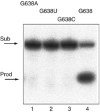
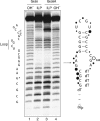
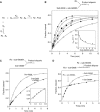
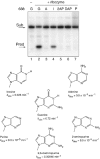
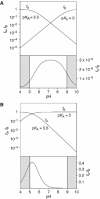
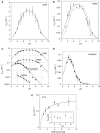
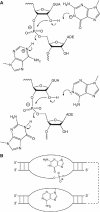
Similar articles
-
Nucleobase-mediated general acid-base catalysis in the Varkud satellite ribozyme.Proc Natl Acad Sci U S A. 2010 Jun 29;107(26):11751-6. doi: 10.1073/pnas.1004255107. Epub 2010 Jun 14. Proc Natl Acad Sci U S A. 2010. PMID: 20547881 Free PMC article.
-
Do the hairpin and VS ribozymes share a common catalytic mechanism based on general acid-base catalysis? A critical assessment of available experimental data.RNA. 2011 Feb;17(2):213-21. doi: 10.1261/rna.2473711. Epub 2010 Dec 20. RNA. 2011. PMID: 21173201 Free PMC article.
-
Folding and catalysis by the VS ribozyme.Biochimie. 2002 Sep;84(9):889-96. doi: 10.1016/s0300-9084(02)01406-2. Biochimie. 2002. PMID: 12458081
-
The structure and active site of the Varkud satellite ribozyme.Biochem Soc Trans. 2002 Nov;30(Pt 6):1170-5. doi: 10.1042/bst0301170. Biochem Soc Trans. 2002. PMID: 12440998 Review.
-
A chemo-genetic approach for the study of nucleobase participation in nucleolytic ribozymes.Biol Chem. 2007 Jul;388(7):699-704. doi: 10.1515/BC.2007.069. Biol Chem. 2007. PMID: 17570822 Review.
Cited by
-
The Small Ribozymes: Common and Diverse Features Observed through the FRET Lens.Springer Ser Biophys. 2009 Jan 1;13:103-127. doi: 10.1007/978-3-540-70840-7_5. Springer Ser Biophys. 2009. PMID: 21796234 Free PMC article.
-
Crystal structure of the Varkud satellite ribozyme.Nat Chem Biol. 2015 Nov;11(11):840-6. doi: 10.1038/nchembio.1929. Epub 2015 Sep 28. Nat Chem Biol. 2015. PMID: 26414446 Free PMC article.
-
Additional roles of a peripheral loop-loop interaction in the Neurospora VS ribozyme.Nucleic Acids Res. 2011 Aug;39(14):6223-8. doi: 10.1093/nar/gkr250. Epub 2011 Apr 20. Nucleic Acids Res. 2011. PMID: 21507887 Free PMC article.
-
An important role of G638 in the cis-cleavage reaction of the Neurospora VS ribozyme revealed by a novel nucleotide analog incorporation method.RNA. 2008 May;14(5):938-49. doi: 10.1261/rna.936508. Epub 2008 Mar 20. RNA. 2008. PMID: 18356538 Free PMC article.
-
Role of SLV in SLI substrate recognition by the Neurospora VS ribozyme.RNA. 2008 Apr;14(4):736-48. doi: 10.1261/rna.824308. Epub 2008 Feb 26. RNA. 2008. PMID: 18314503 Free PMC article.
References
-
- Andersen AA, Collins RA (2000) Rearrangement of a stable RNA secondary structure during VS ribozyme catalysis. Mol Cell 5: 469–478 - PubMed
-
- Beaucage SL, Caruthers MH (1981) Deoxynucleoside phosphoramidites—a new class of key intermediates for deoxypolynucleotide synthesis. Tetrahedron Lett 22: 1859–1862
-
- Bevilacqua PC (2003) Mechanistic considerations for general acid–base catalysis by RNA: revisiting the mechanism of the hairpin ribozyme. Biochemistry 42: 2259–2265 - PubMed
Publication types
MeSH terms
Substances
Grants and funding
LinkOut - more resources
Full Text Sources
Other Literature Sources

